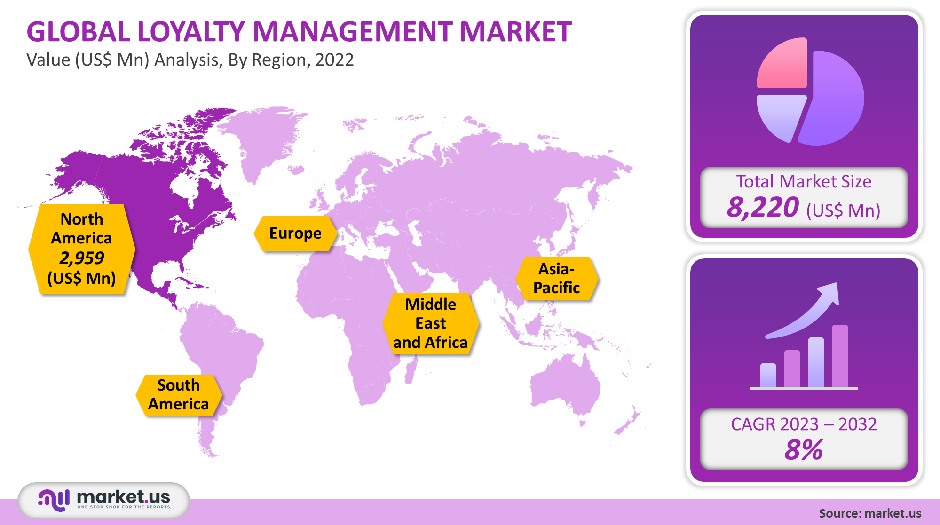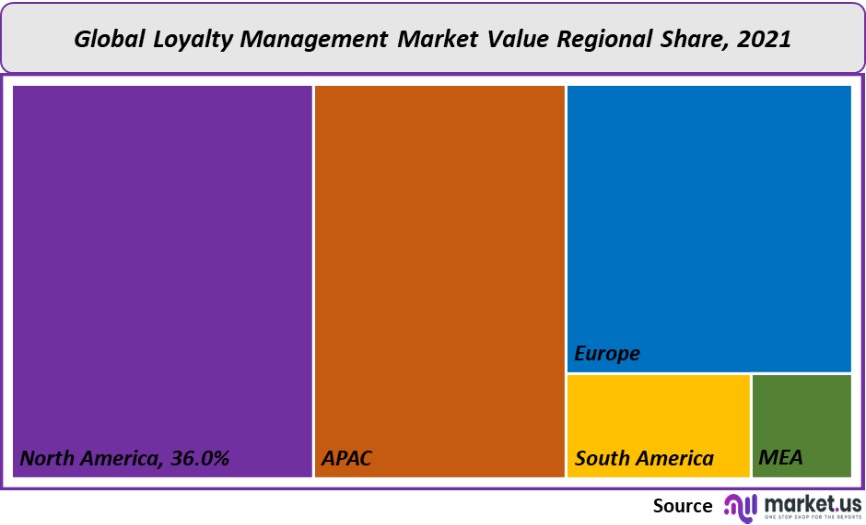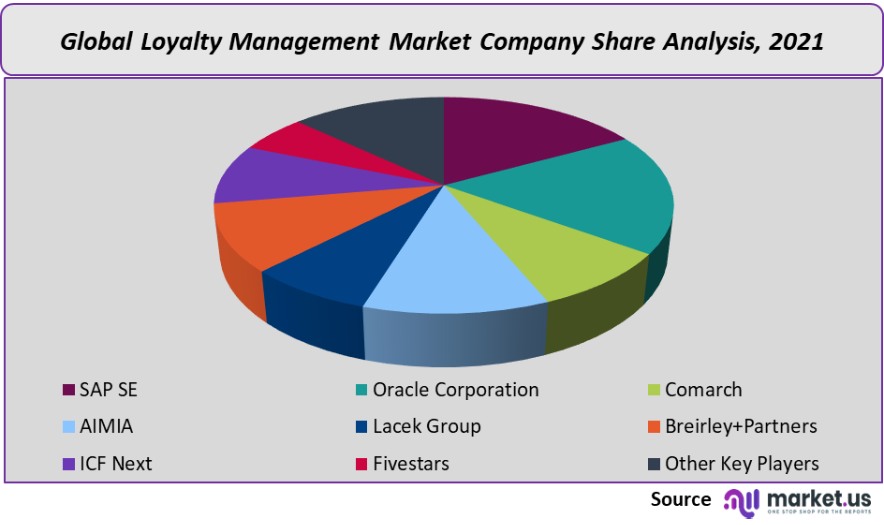Global Loyalty Management Market By Component (Service and Software), By Software (Customer Loyalty, Channel Loyalty, and Customer Retention), By Deployment Mode (Cloud and On-Premise) By Industry Vertical (Retail & Consumer Goods, Transportation, and Others), By Region and Companies - Industry Segment Outlook, Market Assessment, Competition Scenario, Trends and Forecast 2022-2032
- Published date: May 2022
- Report ID: 12217
- Number of Pages: 258
- Format:
- keyboard_arrow_up
Loyalty Management Market Overview:
The loyalty management global market was valued at USD 8,220 million in 2021. This market will grow at a CAGR of 8% from 2023-2032.
Loyalty programs help customers to engage with them and to influence their buying habits. Major factors that are driving market growth include the expanding retail and eCommerce markets as well the shift in business approach towards a customer-centric focus. Market expansion has been encouraged by the easy accessibility to the internet through smartphones and other internet devices.
Global Loyalty Management Market Analysis
Component Analysis
The component type with the highest revenue share was loyalty management software, which accounted for more than half of the total. Because the organization focuses on customer service, loyalty management software has become a key component. The customer loyalty software helps to analyze the results of e-mail marketing campaigns. Organizations are implementing loyalty management programs, allowing them to capture Analysis from their engagement cycle and user experience.
Organizations can use loyalty programs to keep track of data from every touchpoint, including points of sale, feedback, and online payment processes. Data gathered from these touchpoints can be used to develop loyalty programs that provide an enhanced user experience.
The highest CAGR is expected for the software segment at 8.8% over the forecast period. Organizations have adopted loyalty program software because of the rise of e-commerce, the proliferation of mobile technology, and the youth’s interest in rewards-based loyalty programs. This segment is expected to grow due to these factors.

Software Analysis
Customer loyalty held a significant market share in 2021. The loyalty of customers to a particular brand has a significant impact on the buying decisions made by their social circle. This is due to their word of mouth. In order to increase customer numbers and engagement, many companies mix their loyalty programs with referral programs. In order to improve engagement, these programs offer referral codes or help in adding new customers. Referrers are also given a discount, coupon, or free month of subscriptions. The adoption of customer loyalty programs is a major growth factor.
Between 2023 and 2032, the customer retention market will expand at a CAGR of 8.2%. Businesses around the world have faced many challenges with customer retention. Businesses worldwide had to adapt to changing consumer preferences during the COVID epidemic and focus their efforts on retaining customers and implementing loyalty programs. The growth of this segment is driven by the ability of loyalty management programs that engage and increase customers’ loyalty to the brand and organization.
Deployment Mode Analysis
In 2021, more than half the revenue was held by the on-premise deployment mode segment. The main reason for the on-premise deployment is data security concerns and the privacy of customers and employees. Additionally, companies can manage their employees and have control over the system and data through on-premise software installation. CAGR is expected to reach the highest level in the cloud segment during the forecast period.
Cloud-based deployment can support devices and channels such as computers, smartphones, tablets, and social media. With the increasing internet penetration and increased smartphone ownership, online content generation is growing across different social media platforms. Cloud-based deployments of loyalty management solutions are rapidly gaining traction because of their advantages like scalability integration, flexibility in usage extensibility, and the ability to adapt to organizations’ needs and budgets.
Industry Vertical Analysis
In 2021, the consumer goods and retail segment contributed heavily to the global revenue. For customer engagement and to encourage repeat purchases, both retail and consumer brands use loyalty programs extensively. Loyalty programs can include points, cash backs, loyalty punch cards, and coalition loyalty programs. These programs offer to redeem codes, discounts, and gift coupons to cater to different customer segments.
BFSI is expected to experience the greatest CAGR during the forecast period. BFSI firms are now focusing on customer loyalty because of technological advancements. The banking industry is experiencing increasing competition. Banks are now using loyalty management solutions to increase customer engagement, strengthen their relationships with customers, and attract new clients. Customers are increasingly turning to internet banking and mobile banking, which offers banks the chance to attract their customers’ attention and build customer loyalty.
Key Market Segments
By Component
- Service
- Software
By Software
- Customer Loyalty
- Channel Loyalty
- Customer Retention
By Deployment Mode
- Cloud
- On-Premise
By Industry Vertical
- Retail & Consumer Goods
- Transportation
- Hospitality
- BFSI
- Other Industry Verticals
Market Dynamics
Machine Learning (ML), Artificial Intelligence, as well as big data, are being increasingly used in loyalty management programs. These programs can help to evaluate consumer perceptions and develop loyalty programs for all consumer segments. The technology can analyze large quantities of unstructured and structured data such as smartphones, surveys, wearable devices, cookies, and other sources to uncover actionable analyses and drive growth.
Personalized loyalty programs, which offer personalized recommendations that the customer can interact with, are a key factor in customer conversion. Gamification can be integrated into loyalty programs to improve digital engagement, social-sharing, and customer journey. This will help propel the loyalty management market further.
While physical sales were affected by lockdowns in several countries to prevent the spread of coronavirus, online shopping has grown significantly thanks to e-commerce websites. Due to the lockdowns, customers began to shop online. Merchants had to take different measures to retain existing customers and attract new customers.
In order to offer the best possible service to customers, the increasing popularity of online shopping has resulted in initiatives such as free delivery to all members of the new loyalty program. To improve customer engagement, it is crucial for businesses to understand their customers’ preferences and behaviors.
It is no longer enough to get a response from customers. Engagement must also have meaning to help build strong relationships between brands and their customers. An organization has to look at the unstructured and structured data that is generated with every click and find useful Analyses. This data will increase the customer’s lifetime worth, retain customers, as well as create interconnected digital and in-store customer experiences.
Companies can automate their loyalty programs by combining AI and ML while staying current with industry trends. This allows them to provide customers with the best services. Comarch has integrated AI and ML in order to provide personalized service. This allows organizations to create close engagement by offering offers and promotions that are customized for loyalty program members. The micro service uses sentiment analysis to allow organizations to monitor messages, emails, and incoming requests.
The written communication analysis is useful in understanding key behaviors of customers and allowing for loyalty management strategies to be developed accordingly. Digitalization goes one step further with the receipt scanning feature. Customers are able to scan their receipts in order to redeem coupons and rewards. Automation is the basis of receipt scanning. This saves customers time and improves their experience.
Gamification is a popular feature in loyalty management programs. It uses visuals based on cartoons or videos to extract Analysis and increase customer involvement. Gamification is a way for brands to use data to give rewards and offers to consumers. It is easy to misuse consumer data due to loyalty programs’ ever-growing dependency on it.
Organizations cannot access their user data free of charge due to privacy and data security laws. Many companies are now unable to provide meaningful and engaging rewards and experiences that are real and relevant. Similar laws regarding credit cards and banking restrictions forced the BSFI sector’s loyalty management program to be redesigned.
Regional Analysis
North America had a revenue share of 36% in 2021. North America is comprised of well-established economies like the U.S.A and Canada. Loyalty-based retail brands are preferred by customers in the region. Customers in the region prefer financial benefits like cashback, rebates, or product discounts. These are all factors that will help the market grow.
Adoption of new technologies that allow for real-time customer data analysis, real-time reporting, and aggressive investments into AI-based loyalty program programs is driving loyalty management solutions. Many companies prefer to offer customized loyalty programs to different customers to help boost their growth.
Asia Pacific is expected to record the highest CAGR at 9% over the forecast time. The Asia Pacific is home to emerging economies like India, China, and others. The growth of the market is being encouraged by the increasing penetration of internet and social media use, as well as the popularity of e-commerce. In India and China, e-commerce sites allow for debit and credit card transactions. This is also a favorable factor in regional market development.

Key Regions and Countries covered in thе rероrt:
- North America
- US
- Canada
- Mexico
- Europe
- Germany
- UK
- France
- Italy
- Russia
- Spain
- Rest of Europe
- APAC
- China
- Japan
- South Korea
- India
- Rest of Asia-Pacific
- South America
- Brazil
- Argentina
- Rest of South America
- MEA
- GCC
- South Africa
- Israel
- Rest of MEA
Market Share & Key Players Analysis:
Because of the numerous players, this market is extremely competitive. These players have a strong global presence and support many industries like BSFI, hospitality, and SMEs. Oracle continually updates its product line to meet changing customer preferences and loyalty dynamics.
Oracle recently announced changes to its Customer Experience (CX Suit). The suit includes a voice assistant and smart listing features. It also has automated digital services that are supported by artificial Intelligence. To gain a greater market share, players are also developing growth strategies like mergers & acquisitions or strategic partnerships.

Маrkеt Кеу Рlауеrѕ:
- SAP SE
- Oracle Corporation
- Comarch
- AIMIA
- Lacek Group
- Breirley+Partners
- ICF Next
- Fivestars
- Other Key Players
For the Loyalty Management Market research study, the following years have been considered to estimate the market size:
Attribute Report Details Historical Years
2016-2020
Base Year
2021
Estimated Year
2022
Short Term Projection Year
2028
Projected Year
2023
Long Term Projection Year
2032
Report Coverage
Competitive Landscape, Revenue analysis, Company Share Analysis, Manufacturers Analysis, Volume by Manufacturers, Key Segments, Key company analysis, Market Trends, Distribution Channel, Market Dynamics, COVID-19 Impact Analysis, strategy for existing players to grab maximum market share, and more.
Regional Scope
North America, Europe, Asia-Pacific, South America, Middle East & Africa
Country Scope
United States, Canada and Mexico, Germany, France, UK, Russia and Italy, China, Japan, Korea, India and Southeast Asia, Brazil, Argentina, Colombia etc.Saudi Arabia, UAE, Egypt, Nigeria and South Africa
Frequently Asked Questions (FAQ)
What is the size of the Loyalty Management Market in 2021?The Loyalty Management Market size is US$ 8,220 million in 2021.
What is the projected CAGR at which the Loyalty Management Market is expected to grow at?The Loyalty Management Market is expected to grow at a CAGR of 8% (2023-2032).
List the segments encompassed in this report on the Loyalty Management Market?Market.US has segmented the Loyalty Management Market by geographic (North America, Europe, APAC, South America, and Middle East and Africa). By Component, the market has been further divided into Service and Software. By Software, the market has been further divided into Customer Loyalty, Channel Loyalty, and Customer Retention. By Deployment Mode, the market has been further divided into Cloud and On-Premise. By Industry Vertical, the market has been further divided into Retail & Consumer Goods, Transportation, Hospitality, BFSI, and Other Industry Verticals.
List the key industry players of the Loyalty Management Market?SAP SE, Oracle Corporation, Comarch, AIMIA, Lacek Group, Breirley+Partners, ICF Next, Fivestars, and Other Key Players are engaged in the Loyalty Management market
Which region is more appealing for vendors employed in the Loyalty Management Market?North America is expected to account for the highest revenue share of 36%. Therefore, the Loyalty Management industry in North America is expected to garner significant business opportunities over the forecast period.
Name the key areas of business for Loyalty Management?The US, India, China, Canada, UK, Japan, & Germany are key areas of operation for the Loyalty Management Market.
Which segment accounts for the greatest market share in the Loyalty Management industry?With respect to the Loyalty Management industry, vendors can expect to leverage greater prospective business opportunities through the software segment, as this area of interest accounts for the largest market share.
![Loyalty Management Market Loyalty Management Market]()
- SAP SE Company Profile
- Oracle Corporation
- Comarch
- AIMIA
- Lacek Group
- Breirley+Partners
- ICF Next
- Fivestars
- Other Key Players
- settingsSettings
Our Clients
|
Single User
$5,999
$2,999
USD / per unit
save 50% |
Multi User
$7,999
$3,499
USD / per unit
save 55% |
Corporate User
$12,999
$4,499
USD / per unit
save 65% | |
|---|---|---|---|
| e-Access | |||
| Data Set (Excel) | |||
| Company Profile Library Access | |||
| Interactive Dashboard | |||
| Free Custumization | No | up to 10 hrs work | up to 30 hrs work |
| Accessibility | 1 User | 2-5 User | Unlimited |
| Analyst Support | up to 20 hrs | up to 40 hrs | up to 50 hrs |
| Benefit | Up to 20% off on next purchase | Up to 25% off on next purchase | Up to 30% off on next purchase |
| Buy Now ($ 2,999) | Buy Now ($ 3,499) | Buy Now ($ 4,499) |









